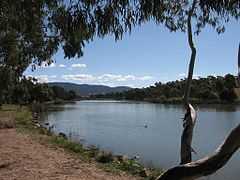Stranger Pond
| Stranger Pond | |
|---|---|
 Looking northwest over one of the two Stranger Ponds, 2007 | |
| Location | Bonython, Australian Capital Territory |
| Coordinates | 35°25′47″S 149°4′11″E / 35.42972°S 149.06972°ECoordinates: 35°25′47″S 149°4′11″E / 35.42972°S 149.06972°E |
| Lake type | Artificial lake |
| Primary inflows | Urban and rural stormwater |
| Primary outflows | Murrumbidgee River, in times of flood only |
| Surface area | 8.5 hectares (21 acres)[1] |
Stranger Pond, a series of two artificial lakes sourced from stormwater discharge from urban and rural areas, are located in the Tuggeranong district of Canberra, within the Australian Capital Territory, Australia.
The two ponds, called Upper Stranger Pond and Lower Stranger Pond, are situated adjacent to the suburb of Bonython.
Features

Stranger Pond was created by the construction of a dam in 1989 across a natural drainage channel, coinciding with urban development in the district. The ponds were built as sediment traps for soil and debris, and to improve the quality of the water flowing into the Murrumbidgee River.[2] Upper Stranger Pond comprises a surface area of 4.4 hectares (11 acres), while Lower Stranger Pond comprises a surface area of 4.1 hectares (10 acres).[1]
Native wildlife, such as pelicans, swans, kangaroos, and wombats, can be found in and around Stranger Pond. In the pond, Carp and Redfin can be caught; carp have been recorded up to 8 kilograms (18 lb) and can be caught on corn; redfin can be caught on celtas and small softplastics, as well as flies.
See also
References
- ↑ 1.0 1.1 "Carp management objectives and preliminary life history and conceptual models for carp habitat use" (PDF). Upper Murrumbidgee Demonstration Reach. 2012. p. 9. Retrieved 17 February 2013.
- ↑ "Lower Stranger Pond". Parks and Recreation: Management of specific lakes and ponds. Government of the Australian Capital Territory. August 2001. Retrieved 17 February 2013.
| ||||||||||||||